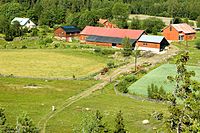
Photo from wikipedia
In order to accomplish economic, social, and environmental objectives, farm diversification is a significant feature in India’s agricultural systems and rural development. It is crucial to examine factors impacting farm… Click to show full abstract
In order to accomplish economic, social, and environmental objectives, farm diversification is a significant feature in India’s agricultural systems and rural development. It is crucial to examine factors impacting farm productivity, such as socio, structural, and Circular Economy (CE) factors, in order to ensure the sustainability of varied farms. A decision to follow a farm circularity approach is required to increase agricultural production, return on investment, and achieve sustainability, so the current study was designed to move forward in identifying farm efficiency and their influencing drivers in production systems for the successful execution of circularity in future farms. The objective of this paper is to find the existing operational efficiency of farms, variables that impact a farm’s efficiency, the disparities in farm efficiency, and variables dominating farm efficiency. The efficiency behaviours of Indian farms operating in 2020–2022 were studied and regressed against the factors influencing farm performance. A two-step technique and survey data were employed. To assess variations in the relevance of drivers, an input-oriented Data Envelopment Analysis was employed; in the second stage, efficiency ratings were used as a dependent variable in a Tobit regression analysis. Explanatory variables for enhancing farm performance included social, structural, and Circular Economy (CE) drivers. The age of the farmer, total farm area, and dryland area as socio-structural variables, and reduce, recycle, and redesign as CE variables, have proven to affect the farm’s efficiencies significantly. Managerial implications in terms of technical, allocative, cost efficiency, and their drivers have been drawn from study findings. CE has been confirmed to be the strategy over which the farmer has complete control and has been found to have a more significant impact on farm efficiency. Social structural determents are second in terms of their impact. Farmers in the region have cushy access to inputs; however, they are not utilized to their maximum effect. Therefore, the study indicates that inefficient dryland farmers could increase their production by concentrating on a circular economy strategy.
Journal Title: Sustainability
Year Published: 2023
Link to full text (if available)
Share on Social Media: Sign Up to like & get
recommendations!